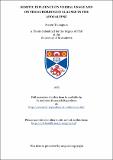Files in this item
Semitic influence on verbal usage and on the subordinate clauses in the apocalypse
Item metadata
| dc.contributor.advisor | Black, Matthew | |
| dc.contributor.author | Thompson, Steven | |
| dc.coverage.spatial | 318 p. | en_US |
| dc.date.accessioned | 2018-06-08T09:14:31Z | |
| dc.date.available | 2018-06-08T09:14:31Z | |
| dc.date.issued | 1975-08 | |
| dc.identifier.uri | https://hdl.handle.net/10023/13838 | |
| dc.description.abstract | The major peculiarities of the language of the Apocalypse related to the usage of the Verb and of the Clause are here explained as due to the influence of the Hebrew and Aramaic languages, not to the author's lack of familiarity with Greek. The approach has been to isolate in each case the usage which is not compatible with Hellenistic Greek syntax, and then to extract from the Septuagint identical constructions. The next step was to determine the type of Hebrew/ Aramaic construction responsible for the anomaly in the Septuagint, and then to apply the same explanation to the identical construction in the Apocalypse. While this method has proven to be fundamentally sound and reliable, it is a strange fact that previous treatments of the Semitic element in the language of the Apocalypse have failed to apply it consistently. Another basic presupposition of this thesis is that the research should not be restricted to a single-Greek manuscript or printed text of the Apocalypse. Instead, an eclectic approach is made, which respects any manuscript evidence supporting the more semitised construction. The study included every significant facet of verbal usage from that of lexicography, Voice, Mood, Tenses of the Finite Verb, case additions to the verb, and the Infinitive and Participle. Included in the section on Clauses were Noun - and Verbal - Clauses, plus the Subordinate Clauses such as Relative, Circumstantial, Conditional, Temporal, Final, and Consecutive. Specific types of Semitic influence were seen to be present in each section listed. In at least some cases the Semitic influence was of such a direct nature that it could be explained only as due to direct translation from a Semitic source. While the evidence points predominantly to Hebrew sources underlying the Apc., the case for Aramaic influence at some points cannot be ruled out without doing an injustice to the facts. The results of this study, based as they are on directly observable Semitic influence on the Greek of the LXX, can be applied to any Jewish translation Greek text, to serve as a syntactical survey of that language. The study also demonstrated that the eclectic approach to the text of the Apocalypse is the only sound one, because no single manuscript or family of manuscripts has preserved a majority of the semitised (and therefore more nearly original) readings. | en_US |
| dc.language.iso | en | en_US |
| dc.publisher | University of St Andrews | |
| dc.subject.lcc | BS2821.T7 | en |
| dc.subject.lcsh | Bible. Revelation--Criticism, interpretation, etc. | en |
| dc.title | Semitic influence on verbal usage and on the subordinate clauses in the apocalypse | en_US |
| dc.type | Thesis | en_US |
| dc.type.qualificationlevel | Doctoral | en_US |
| dc.type.qualificationname | PhD Doctor of Philosophy | en_US |
| dc.publisher.institution | The University of St Andrews | en_US |
This item appears in the following Collection(s)
Items in the St Andrews Research Repository are protected by copyright, with all rights reserved, unless otherwise indicated.

